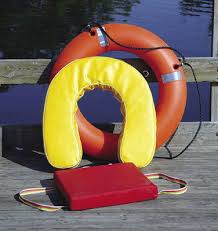 “Nine out of ten drowning victims were not wearing a life jacket”, California Boating & Waterways sign. In my trade we often deal with tragedies, many of which were preventable by flotation devices. As in all safety systems, it is good to take a moment to reflect, maintain, and plan for events that may involve flotation devices.
“Nine out of ten drowning victims were not wearing a life jacket”, California Boating & Waterways sign. In my trade we often deal with tragedies, many of which were preventable by flotation devices. As in all safety systems, it is good to take a moment to reflect, maintain, and plan for events that may involve flotation devices.
U.S. Federal law requires one approved flotation device to be aboard for each passenger and the flotation device to be suitably sized. Logic dictates they should be easily accessible in situations when they may be required. Think flybridge, cockpit or an easily accessible locker on a small boat. Remember small boats can tip and life jackets can fall out. A sure way to keep the life jacket with you is to wear it.
Inflatable type flotation devices are much likely to be worn. Remember to maintain them per the manufacturers’ recommendations. And pull out those old PFD’s and discard the deteriorated ones (if you can rip a strap off, throw it away).
In times of flooding emergencies it is easy to get your passengers to wear a life jacket. Consider other risky activities like gathering fenders, lines, anchoring, launching tenders, heavy weather, etc… Remember to don life jackets in advance, the more it gets done, the more likely it will be on when needed. If the passengers or kids see the captain wearing a PFD, they will be more likely to wear one as well (it becomes like a seat belt if you start kids early).
Remember to discuss the location, type and proper use of personal flotation devices to all passengers at the onset of any outing. Know that some passengers feel safer wearing a life jacket at all times, particularly non-swimmers. Make sure all passengers know how to use the PFDs.
Remember throwable flotation devices are extremely useful, particularly for the accidental swimmer. Throw rings, throw ropes, horseshoe buoys, Life Slings, Man Overboard Modules, lights, whistles and man overboard poles help in different weather and lighting conditions. Does your boat have a reboarding device that is deployable by the accidental swimmer? Could you get back aboard if you fell in now?
The ultimate inflatable, the life raft, requires maintenance. If you are betting your life on it, it is worth the cost to maintain.
Don’t forget to consider other risks such as cold water and for boaters in freshwater marinas the possibility of electric shock, know how to spot this condition and learn how to react. The first rule of life saving is to not lose another person while trying to save one.
This article was edited on February 29, 2016.